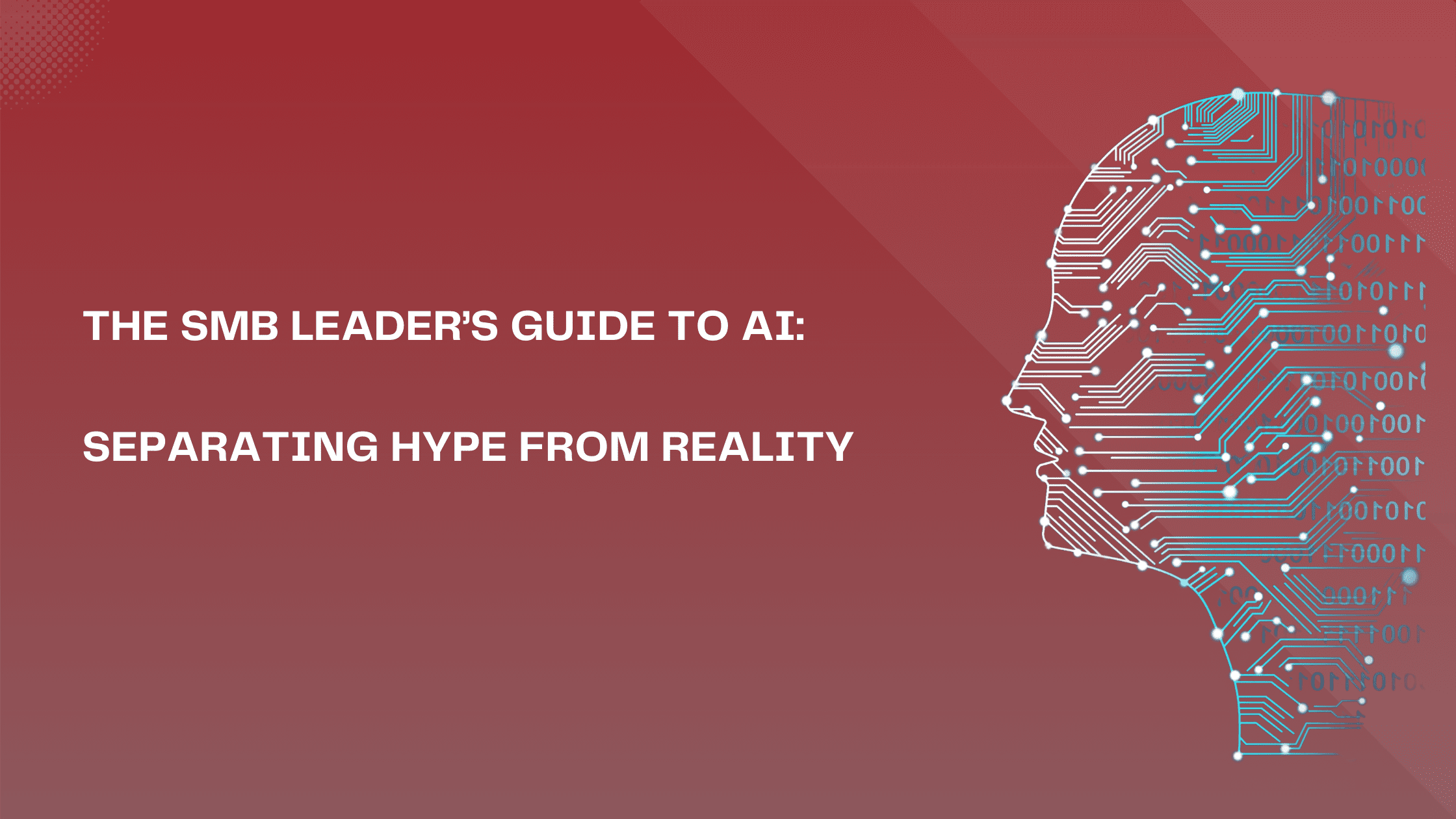Introduction: Why AI Matters for SMBs
Artificial intelligence (AI) is no longer just for tech giants.
Small and medium-sized businesses (SMBs) are already using AI-powered tools, sometimes without realizing it. From automated customer support chatbots to predictive analytics in marketing, AI is becoming mainstream.
For SMB leaders, the challenge isn’t just about adopting AI—it’s about understanding what’s real and what’s hype.
Misconceptions about AI can lead to unrealistic expectations, wasted investments, or missed opportunities. This guide will help you separate fact from fiction so you can make informed decisions about AI adoption.
→ Want to see how ready your SMB is for AI? Use our AI Readiness Checklist for SMBs.
What’s Hype and What’s Real About AI
Hype #1: AI is a Silver Bullet That Solves Business Challenges Overnight
Reality: AI is a powerful tool, but it excels in specific, defined tasks like automation, data analytics, and writing short, well defined sections of content like marketing emails. It cannot independently solve complex business problems or replace sound business strategy. Success depends on aligning AI solutions with clear business goals.
Pro Tip: Start small by using AI to enhance existing workflows. Focus on tasks like drafting emails, generating quick summaries of lengthy reports, training chatbots on simple FAQs, creating AI-generated marketing content, searching documents, or transcribing meetings. These applications are low-risk and can demonstrate immediate value.
Hype #2: AI Will Replace Entire Jobs and Industries
Reality: AI is a tool for automation, not a replacement for human expertise. It takes over repetitive or data-driven tasks but lacks the ability to fully replace roles that require creativity, judgment, and interpersonal skills.
Example: AI can generate financial reports, but CFOs are still needed to interpret data, make strategic decisions, and manage risk.
Hype #3: AI Can Think and Learn Like Humans
Reality: AI can process patterns in data but lacks common sense, emotional intelligence, and ethical reasoning. AI-driven decisions must be monitored to avoid errors and biases.
Pro Tip: AI can analyze customer sentiment based on keywords, but it lacks true emotional understanding. Always pair AI insights with human interpretation to avoid misjudgments.
Hype #4: AI is Autonomous and Unbiased
Reality: AI does not operate independently—it requires human setup, training, and continuous oversight. Even systems marketed as “autonomous,” like self-driving cars, depend on human intervention in complex or unpredictable situations. Additionally, AI’s accuracy and fairness are limited by the quality of its training data. Biases in the data can lead to unintended discrimination if not carefully monitored and corrected.
Risk: Without ongoing human input, AI models may make errors, reinforce harmful patterns, or drift from their intended purpose.
Example 1: An AI chatbot may initially perform well but can generate misleading responses over time without regular updates and fine-tuning.
Example 2: An AI-powered mortgage approval system may avoid racial bias but unintentionally discriminate against older applicants due to gaps in the dataset.
Hype #5: AI is Plug-and-Play
Reality: AI tools require time for integration, customization, and user training. Organizations that expect instant results without a vision, strategy, or investment in training and process alignment often face disappointment.
Pro Tip: Start with a vision of how AI will play a role in your business and ensure to train employees on AI tools to ensure they are used effectively. “Garbage in, garbage out” applies to AI—poor data or prompts lead to poor results.
For example, at Third Octet, our AI vision is to responsibly and thoughtfully enhance human intelligence, expertise, and ingenuity with AI. Staying true to our core values, we strive to create exceptional customer and employee experiences while elevating human and organizational potential.
→ Want to see how ready your SMB is for AI? Use our AI Readiness Checklist for SMBs.
Why Leadership Matters in AI Adoption
Many AI initiatives fail not because of poor technology, but due to a lack of leadership engagement. SMB leaders play a critical role in:
- Understanding AI’s strengths and limitations.
- Educating teams and addressing skepticism.
- Setting realistic AI adoption goals.
- Encouraging cross-functional AI strategies rather than siloed implementations.
- Demonstrating the value-add of AI in augmenting existing skillsets.
Practical First Steps for SMB Leaders
- Define your AI Vision. Determine how AI aligns with your business goals and what success looks like. Feel free to use ours as an example to build on.
- Identify Key Business Needs: Focus on areas where AI can drive efficiency (e.g., customer service, marketing automation, data analysis, or inventory management).
- Start Small: Implement AI in one function before expanding.
- Leverage Existing Tools: Many SMB-friendly platforms already include AI features – e.g., Microsoft Copilot, Gemini in Google Workspace, and AI-enhanced CRMs.
- Train Your Team: Equip employees with knowledge to maximize AI benefits.
- Monitor and Adjust: Track AI performance and refine how it’s used over time.
Conclusion: Understanding AI’s True Potential
AI offers SMBs powerful tools to improve efficiency, customer experience, and decision-making. However, success requires separating fact from fiction. By focusing on strategic AI adoption, SMB leaders can harness its potential for long-term business growth.
Ready to explore AI for your SMB?
Schedule a call with us to learn more about our AI methodology, and how it can benefit your business.
Why Choose Third Octet for AI Integration?
01. Real-World Experience: We’re actively adopting AI, testing what works, discarding what doesn’t, and refining our approach so you don’t have to.
02. Strategic Expertise: We help SMBs navigate AI adoption with tailored, business-aligned strategies.
03. Holistic Approach: Our focus is on breaking down silos and building scalable AI ecosystems that drive real impact.
04. Comprehensive Support: From pilot projects to long-term implementation, we provide end-to-end guidance to ensure AI delivers measurable value.




0 Comments